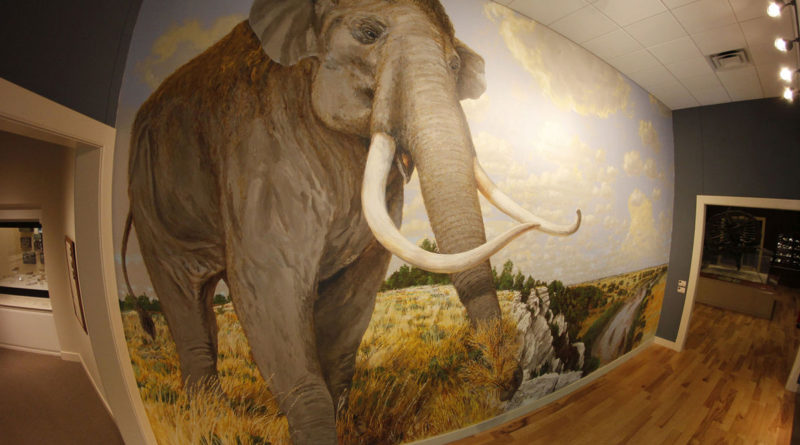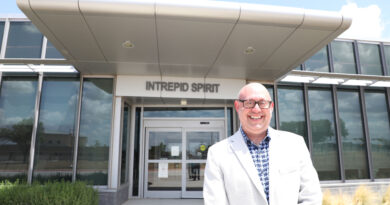Baylor’s Mayborn Museum invites visitors to step into the past
Wander around a 19th century settlement, immerse yourself in the sound and light of a Texas cave and peer at bone tools created by humans 12 thousand years ago — all in a day. A trip to the Mayborn Museum Complex in Waco is like stepping into a time machine, except there’s air conditioning.
Make sure you arrive early, as you could easily spend hours wandering through the varying and engaging exhibits. Begin in the Cabinet of Curiosities, designed to pay homage to what natural history museums looked like around the turn of the century, when the museum was established.
“In the 1850s the professors at Baylor University started collecting teaching specimens like rocks, minerals, animals and artifacts,” Exhibits Manager Trey Crumpton said. “That’s how our natural history collection got started.”
The museum was officially established in 1893. The Cabinet of Curiosities holds many of the original items, including walrus tusks from Alaska, a necklace from the Masai tribe in Tanzania, a Megalodon tooth and a humpback whale skull from Brazil. Most of the items were brought back by Baptist missionaries. The artifacts are arranged close together in glass cabinet display cases, as was the style, and visitors can open the attached drawers and peer inside. An interactive display offers information on every item’s past.
Though Baylor’s museum has existed in some form for more than a century, the complex was named The Mayborn Museum in 2004.
“In the last 15 years or so we’ve really redefined our scope,” Crumpton said. “The museum is geared toward Central Texas.”
Stepping into history
Begin your journey into the natural and cultural history of Central Texas in the Cretaceous Sea Exhibit. According to Crumpton, most of Texas was under a shallow sea for a long period, which is why dinosaur bones are not found in most parts of the state. It’s also why there is so much white rock, which comes from marine deposits.
Fossils, bones and even a cast containing a flipper are on display. A life- size model of a pliosaur, which looks like a mix between a shark and a dinosaur, hangs above the room and adds awe and understanding to the remnants of the sea age.
A free cellphone tour correlates with all the exhibits. Visitors can call a number listed on the display to hear more information about what they are looking at.
Next, explore the museum’s traditional and walk-in dioramas. The walk-in Texas Caves exhibit instantly sends you into a hushed, dripping and dim underground world. The walk-in Texas Forests exhibit has about a dozen taxidermied animals to try and spot, including birds in the trees, bats, a raccoon, owl, grey fox, bobcat, bear, box turtle and more.
The Mayborn Museum has a great partnership with the Waco Mammoth National Monument, Crumpton said. The museum re-created the find. Glass covers the model dig so visitors can stand directly over the mammoth remains and get a much closer look than at the actual site. A video with information about the Columbian mammoths and the archaeological find plays nearby. Patrons are encouraged to visit the real site, which is about five miles away, after learning about it.
A mural outside of the exhibit depicts a life-size illustration of a Columbian mammoth for visitors to stand next to and comprehend the creature’s size. It also makes a great photo opportunity, as the background shows what Waco’s Cameron Park would have looked like during the Mammoth age, complete with the Brazos River, cliffs, horses, camels and saber tooth cats, also found at the mammoth site.
Computer games are dispersed throughout the natural history area of the museum. Children can answer questions about the correlating exhibit and receive a letter at the end of each game. Combine the letters to form a word, present the word at the gift shop and receive a prize.
The Horn Shelter exhibit offers a glimpse at one of the most important archaeological sites in the country, Crumpton said.
The site, which was found along the Brazos River, shows continuous human occupation at that location for about 12,000 years. A miniature diagram shows the artifacts that were found under each layer of earth and how they can be dated.
“The Smithsonian wanted most of the materials,” Crumpton said. “But we have artifacts on loan from them — a beaver jaw, bone fish hooks, bone tools — it’s just really cool when you think about how long ago this was. Someone was sitting near here making those fish hooks 11,000 years ago, the one’s we’re looking at right there.”
Native inhabitants and Anglo settlers
The next room, Texas Life Ways, hurdles you ahead through history. The exhibit gives visitors an idea of various common dwellings found in Central Texas in the mid-19th century.
The Waco Grass House, replicating those inhabited by the Waco Indians, is furnished with buffalo robes, deer skins and a central fire pit. Bunk beds, which were often three levels high, wrap around the edges. There is also a Comanche teepee, Anglo log house and Norwegian rock house, all life size.
Leave the mid-19th century behind when you head outside into the Governor Bill and Vara Daniel Historic Village, which is representative of the late-19th century after railroads had been established. The collection of buildings and artifacts that make up the historic village were donated to Baylor University in the 1980s. Some of the buildings are sealed for climate control, but you can peer through the windows for a snapshot of what life was like at the turn of the century. Many of the buildings are open to visitors.
You can play the 100-year-old piano in the church and ring the bell, sit on the benches in the one-room schoolhouse and tidy up the kitchen in the tenant house. You can go inside the furnished general store, property owner’s house and cook’s quarters and look into a law office, barn and blacksmith’s shop, which is used for live demonstrations during programs and special events.
The village is complete with vegetable and herb gardens, and sits on land next to the Brazos River. There are plenty of picnic areas for visitors who packed a lunch and want to take a break to enjoy their food and digest all the information obtained so far.
Learn about science
After meandering around the village and taking a rest, head back inside and upstairs for the second portion of the museum to The Jeanes Discovery Center.
The center has 15 themed rooms that focus on science. Areas include live animal exhibits, interactive space to learn about light and sound through experimentation and play, a weather room, a communication room, a children-of-the-world room, a tea room and an age five and under area that was recently renovated.
“Some people call this the kids’ side and the natural history area the adult side,” Crumpton said. “But we don’t like to box ourselves in that way, because adults love this side and kids love the natural history side, as well.”
The upstairs also holds workshop spaces for programming, a craft room and design den.
It’s easy to lose track of time when you’re playing a laser harp or launching balls of air out of an air cannon.
Make sure you leave enough time to check out the museum’s special exhibit before you go. “Speed: Science in Motion” runs through Sept. 3. Families can explore three areas: the race track, the fitness testing area and the workshop with 20 interactive set ups. In January, the special exhibit will feature the Teenage Mutant Ninja Turtles and in May of 2018 “Titanic: The Artifact Exhibition” will come to town.
The museum’s cafeteria has vending machines and space for eating any packed snacks, but if you’re ready for a bigger meal after a day of imagining and learning check out one of Waco’s local restaurants.




